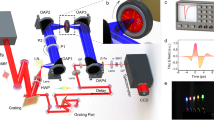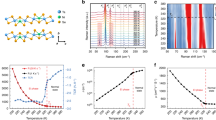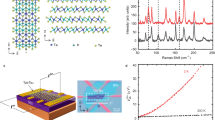Abstract
The development of terahertz-sensing technologies has been limited by the lack of sensitive, broadband and fast terahertz detectors. Thermal bolometers are bulky and slow, whereas electronic terahertz detectors (such as Schottky diodes) are fast, but their sensitivity degrades quickly outside a narrow frequency window. Here, we show that a two-dimensional correlated topological semimetal, tantalum iridium telluride (TaIrTe4), has a large room-temperature nonlinear Hall effect and that the interaction between this effect and terahertz nonlinear electrodynamics can be used as a mechanism for terahertz sensing. Our photodetectors exhibit a high sensitivity (noise-equivalent power of around 1 pW Hz−1/2) and a large zero-bias responsivity (around 0.3 A W−1) over a broadband spectral range (0.1–10 THz) at room temperature with an intrinsic ultrafast response time (picoseconds). The zero-bias responsivity and noise-equivalent power performance can be further improved (to 18 A W−1 and 0.05 pW Hz−1/2, respectively) by introducing gate-tunable electron correlations.
This is a preview of subscription content, access via your institution
Access options
Access Nature and 54 other Nature Portfolio journals
Get Nature+, our best-value online-access subscription
$32.99 / 30 days
cancel any time
Subscribe to this journal
Receive 12 digital issues and online access to articles
$119.00 per year
only $9.92 per issue
Buy this article
- Purchase on SpringerLink
- Instant access to full article PDF
Prices may be subject to local taxes which are calculated during checkout




Similar content being viewed by others
Data availability
The data that support the plots within this paper and other findings of this study are available via Dryad (an open-access data repository) at https://doi.org/10.5061/dryad.d7wm37qcg. Source data are provided with this paper.
Code availability
The codes used for the calculations are available from the corresponding authors on reasonable request.
References
Sengupta, K., Nagatsuma, T. & Mittleman, D. M. Terahertz integrated electronic and hybrid electronic–photonic systems. Nat. Electron. https://doi.org/10.1038/s41928-018-0173-2 (2018).
Damari, R. et al. Strong coupling of collective intermolecular vibrations in organic materials at terahertz frequencies. Nat. Commun. 10, 3248 (2019).
Gomonay, O., Baltz, V., Brataas, A. & Tserkovnyak, Y. Antiferromagnetic spin textures and dynamics. Nat. Phys. https://doi.org/10.1038/s41567-018-0049-4 (2018).
Dang, S., Amin, O., Shihada, B. & Alouini, M. S. What should 6G be? Nat. Electron. 3, 20–29 (2020).
Lewis, R. A. A review of terahertz detectors. J. Phys. D: Appl. Phys. https://doi.org/10.1088/1361-6463/ab31d5 (2019).
Valušis, G., Lisauskas, A., Yuan, H., Knap, W. & Roskos, H. G. Roadmap of terahertz imaging 2021. Sensors https://doi.org/10.3390/s21124092 (2021).
Yachmenev, A. E., Khabibullin, R. A. & Ponomarev, D. S. Recent advances in THz detectors based on semiconductor structures with quantum confinement: a review. J. Phys. D: Appl. Phys. 55, 193001 (2022).
Rogalski, A. Progress in performance development of room temperature direct terahertz detectors. J. Infrared Millim. Terahertz Waves https://doi.org/10.1007/s10762-022-00882-2 (2022).
Hesler, J. L. & Crowe, T. W. NEP and responsivity of THz zero-bias Schottky diode detectors. In Proc. IRMMW-THz2007 – Conference Digest of the Joint 32nd International Conference on Infrared and Millimetre Waves and 15th International Conference on Terahertz Electronics 844–845 (IEEE, 2007).
Yadav, R. et al. State-of-the-art room temperature operable zero-bias Schottky diode-based terahertz detector up to 5.56 THz. Sensors 23, 3469 (2023).
Shen, Y. et al. Nonlinear photocurrent in quantum materials for broadband photodetection. Prog. Quantum Electron. 97, 100535 (2024).
Wang, Q. et al. Robust edge photocurrent response on layered type II Weyl semimetal WTe2. Nat. Commun. 10, 5736 (2019).
Ma, J. et al. Nonlinear photoresponse of type-II Weyl semimetals. Nat. Mater. 18, 5736 (2019).
Kang, K., Li, T., Sohn, E., Shan, J. & Mak, K. F. Nonlinear anomalous Hall effect in few-layer WTe2. Nat. Mater. https://doi.org/10.1038/s41563-019-0294-7 (2019).
Ma, Q. et al. Observation of the nonlinear Hall effect under time-reversal-symmetric conditions. Nature 565, 337–342 (2019).
Xiao, J. et al. Berry curvature memory through electrically driven stacking transitions. Nat. Phys. 16, 1028–1034 (2020).
Kumar, D. et al. Room-temperature nonlinear Hall effect and wireless radiofrequency rectification in Weyl semimetal TaIrTe4. Nat. Nanotechnol. 16, 421–425 (2021).
Sodemann, I. & Fu, L. Quantum nonlinear Hall effect induced by Berry curvature dipole in time-reversal invariant materials. Phys. Rev. Lett. 115, 216806 (2015).
Du, Z. Z., Wang, C. M., Sun, H.-P., Lu, H.-Z. & Xie, X. C. Quantum theory of the nonlinear Hall effect. Nat. Commun. 12, 5038 (2021).
Tiwari, A. et al. Giant c-axis nonlinear anomalous Hall effect in Td-MoTe2 and WTe2. Nat. Commun. 12, 2049 (2021).
Boyd, G. D. & Pollack, M. A. Microwave nonlinearities in anisotropic dielectrics and their relation to optical and electro-optical nonlinearities. Phys. Rev. B 7, 5345 (1973).
Bortz, M. L., Eyres, L. A. & Fejer, M. M. Depth profiling of the d33 nonlinear coefficient in annealed proton exchanged LiNbO3 waveguides. Appl. Phys. Lett. 62, 2012–2014 (1993).
Zhang, Y. & Fu, L. Terahertz detection based on nonlinear Hall effect without magnetic field. Proc. Natl Acad. Sci. USA 118, e2100736118 (2021).
Zhang, J. et al. Colossal room-temperature terahertz topological response in type-II Weyl semimetal NbIrTe4. Adv. Mater. 34, 2204621 (2022).
Hu, Z. et al. Terahertz nonlinear Hall rectifiers based on spin-polarized topological electronic states in 1T-CoTe2. Adv. Mater. 35, 2209557 (2023).
Belopolski, I. et al. Signatures of a time-reversal symmetric Weyl semimetal with only four Weyl points. Nat. Commun. 8, 942 (2017).
Kang, K., Li, T., Sohn, E., Shan, J. & Mak, K. F. Nonlinear anomalous Hall effect in few-layer WTe2. Nat. Mater. 18, 324–328 (2019).
Sun, D. et al. Ultrafast hot-carrier-dominated photocurrent in graphene. Nat. Nanotechnol. 7, 114–118 (2012).
Zaccardi, Z. B. et al. Enabling high-power, broadband THz generation with 800-nm pump wavelength. Opt. Express 29, 38084–38094 (2021).
Yoshioka, K. et al. On-chip transfer of ultrashort graphene plasmon wave packets using terahertz electronics. Nat. Electron. 7, 537–544 (2024).
Hwang, E. H. & Das Sarma, S. Linear-in-T resistivity in dilute metals: a Fermi liquid perspective. Phys. Rev. B 99, 085105 (2019).
Palstra, T. T. M., Hebard, A. F., Haddon, R. C. & Littlewood, P. B. Fermi-liquid behavior in the electrical resistivity of K3C60 and Rb3C60. Phys. Rev. B 50, 3462 (1994).
Grissonnanche, G. et al. Linear-in temperature resistivity from an isotropic Planckian scattering rate. Nature 595, 667–672 (2021).
Shen, B. et al. Strange-metal behaviour in a pure ferromagnetic Kondo lattice. Nature 579, 51–55 (2020).
Bhoi, D. et al. Interplay of charge density wave and multiband superconductivity in 2H-PdxTaSe2. Sci. Rep. 6, 24068 (2016).
Liao, M. et al. Coexistence of resistance oscillations and the anomalous metal phase in a lithium intercalated TiSe2 superconductor. Nat. Commun. 12, 5342 (2021).
Tang, J. et al. Dual quantum spin Hall insulator by density-tuned correlations in TaIrTe4. Nature 628, 515–521 (2024).
Du, Z. Z., Wang, C. M., Li, S., Lu, H. Z. & Xie, X. C. Disorder-induced nonlinear Hall effect with time-reversal symmetry. Nat. Commun. 10, 3047 (2019).
Ma, C. et al. Intelligent infrared sensing enabled by tunable moiré quantum geometry. Nature 604, 266–272 (2022).
Kresse, G. & Hafner, J. Ab initio molecular dynamics for liquid metals. Phys. Rev. B 47, 558 (1993).
Fröhlich, H. On the theory of superconductivity: the one-dimensional case. Proc. R. Soc. A: Math. Phys. Eng. Sci. 223, 296–305 (1954).
Zhang, Y., Sun, Y. & Yan, B. Berry curvature dipole in Weyl semimetal materials: an ab initio study. Phys. Rev. B 97, 041101 (2018).
Sundaram, G. & Niu, Q. Wave-packet dynamics in slowly perturbed crystals: gradient corrections and Berry-phase effects. Phys. Rev. B 59, 14915 (1999).
Viti, L. et al. Plasma-wave terahertz detection mediated by topological insulators surface states. Nano Lett. 16, 80–87 (2016).
Guo, C. et al. Anisotropic ultrasensitive PdTe2-based phototransistor for room-temperature long-wavelength detection. Sci. Adv. 6, eabb6500 (2020).
Auton, G. et al. Terahertz detection and imaging using graphene ballistic rectifiers. Nano Lett. 17, 7015–7020 (2017).
Viti, L. et al. Black phosphorus terahertz photodetectors. Adv. Mater. 27, 5567–5572 (2015).
Westlund, A. et al. Terahertz detection in zero-bias InAs self-switching diodes at room temperature. Appl. Phys. Lett. 103, 133504 (2013).
Acknowledgements
T.X., J.R. and J.X. acknowledge primary support from the Office of Naval Research (Grant No. N00014-24-1-2068). C.F. and J.X. acknowledge further support from the US National Science Foundation (Grant No. DMR-2237761). Y.M., H.J. and Y.W. acknowledge support from the Department of Energy, Office of Basic Energy Sciences (Grant No. DE-SC0024176). J.L. and L.P. are supported by the National Science Foundation Materials Research Science and Engineering Center programme through the UT Knoxville Center for Advanced Materials and Manufacturing (Grant No. DMR-2309083). Y.Z. is supported by the start-up fund at the University of Tennessee Knoxville. D.R. and Y.H. acknowledge support from the National Science Foundation through the University of Wisconsin Materials Research Science and Engineering Center (Grant No. DMR-2309000). K.W. and T.T. acknowledge support from the JSPS (KAKENHI Grant Nos. 21H05233 and 23H02052) and the World Premier International Research Center Initiative, MEXT, Japan. Y.G. and D.v.d.W. are supported by the US Office of Naval Research under PANTHER award number N00014-24-1-2200 through T. Bentley.
Author information
Authors and Affiliations
Contributions
J.X. conceived the research. J.X. and T.X. designed the experiments. Y.W. and J.X. supervised the project. Y.H. synthesized the bulk high-quality TaIrTe4 crystals under the guidance of D.R. T.T. and K.W. provided the high-quality hBN bulk crystals. Y.G. designed the terahertz-sensing device with H.J. and T.X. under the guidance of D.v.d.W., Y.W. and J.X. Besides, H.J., C.F., T.X. and Y.M. fabricated the devices under the guidance of Y.W. and J.X. In addition, T.X. performed the terahertz photocurrent and SHG measurements and analysed the data with J.X. J.R. conducted the atomic force microscopy measurements. T.X. and H.J. conducted electrical transport measurements. J.L., L.P. and Y.Z. performed the first-principles and Hartree–Fock calculations. All authors discussed the results and jointly wrote the paper.
Corresponding authors
Ethics declarations
Competing interests
J.X., Y.W. and D.v.d.W. have submitted a patent application (‘Terahertz radiation detectors based on thin films of non-centrosymmetric layered topological semimetals’; US No. 18/448,648) that covers a specific aspect of the manuscript. The other authors declare no competing interests.
Peer review
Peer review information
Nature Electronics thanks Xinlong Xu, Changgan Zeng and the other, anonymous, reviewer(s) for their contribution to the peer review of this work.
Additional information
Publisher’s note Springer Nature remains neutral with regard to jurisdictional claims in published maps and institutional affiliations.
Supplementary information
Supplementary Information
Supplementary Information Sections 1–18 and Figs. 1–17.
Source data
Source Data Fig. 1
Source data for Figs. 1b–d.
Source Data Fig. 2
Source data for Figs. 2b–g.
Source Data Fig. 3
Source data for Figs. 3a–f.
Source Data Fig. 4
Source data for Figs. 4a–f.
Rights and permissions
Springer Nature or its licensor (e.g. a society or other partner) holds exclusive rights to this article under a publishing agreement with the author(s) or other rightsholder(s); author self-archiving of the accepted manuscript version of this article is solely governed by the terms of such publishing agreement and applicable law.
About this article
Cite this article
Xi, T., Jiang, H., Li, J. et al. Terahertz sensing based on the nonlinear electrodynamics of the two-dimensional correlated topological semimetal TaIrTe4. Nat Electron 8, 578–586 (2025). https://doi.org/10.1038/s41928-025-01397-z
Received:
Accepted:
Published:
Issue date:
DOI: https://doi.org/10.1038/s41928-025-01397-z



